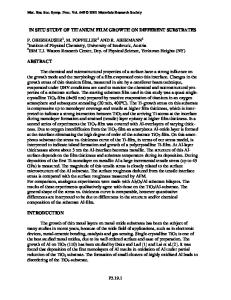Determination of Benzo[a]pyrene in Roast Meat by In Situ Growth of Covalent Organic Framework on Titanium Wire for Solid
- PDF / 1,226,644 Bytes
- 9 Pages / 595.276 x 790.866 pts Page_size
- 88 Downloads / 239 Views
Determination of Benzo[a]pyrene in Roast Meat by In Situ Growth of Covalent Organic Framework on Titanium Wire for Solid-Phase Microextraction Coupled with GC-FID Yue-Hong Pang 1
&
Miao Sun 1 & Xiao-Fang Shen 1 & Qi Yue 1 & Tian-Tian Ma 1 & Cheng Yang 1
Received: 3 January 2020 / Accepted: 28 June 2020 # Springer Science+Business Media, LLC, part of Springer Nature 2020
Abstract Benzo[a]pyrene (BaP) is a kind of trace pollutant commonly found in environment, food, and organism. It has been widely concerned because of its strong carcinogenicity to the human body. In this paper, covalent organic framework TpBD, in situ growth on titanium wire, was used as the coating of solid-phase microextraction (SPME) fiber and coupled with gas chromatography–flame ionization detector (GC-FID) for the detection of trace BaP in roast meat samples. The linear range of the developed method under the optimized experimental conditions was 0.02–15 μg L−1, the detection limit (S/N = 3) was 0.006 μg L−1, and the limit of quantification (S/N = 10) was 0.02 μg L−1. The intra-day and inter-day precision of a single fiber were 1.73% and 2.27%, respectively. The relative standard deviation (RSD) between fiber-to-fiber was investigated by three asfabricated fibers was 6.09%. Moreover, the enrichment factor of the fabricated TpBD SPME fiber for BaP was 4914, and the fiber can withstand at least 150 cycles of adsorption and desorption without significantly decrease in extraction efficiency (< 3.6%). Finally, the developed method was successfully applied to the detection of BaP in roast meat samples with the recoveries from 95.4 to 108.5%. Keywords Benzo[a]pyrene . Solid-phase microextraction . Covalent organic frameworks . Gas chromatography . Roast meat
Introduction Polycyclic aromatic hydrocarbons (PAHs) are a large class of highly lipophilic organic contaminants produced by incomplete combustion of organic substances and are widely found in food and environment (Garcia Londoño et al. 2015). According to the report of the Food Science Committee, many PAHs have obvious carcinogenicity, mutagenicity, and genotoxicity to somatic cells of experimental animals (Surma et al. 2014). Therefore, PAHs have been listed as priority control of organic pollutants by the US Environmental Protection Agency (Li et al. 2015). PAHs mainly enter the human body through food intake and cause serious damage to the human body. Inappropriate food processing methods, such as smoking, grilling, roasting, baking,
* Yue-Hong Pang [email protected] 1
State Key Laboratory of Food Science and Technology, School of Food Science and Technology, Jiangnan University, Wuxi 214122, People’s Republic of China
and frying, are the main sources of PAHs in food (Yang et al. 2019a; Farhadian et al. 2011). Benzo[a]pyrene (BaP), as a strong carcinogen in the PAHs family with the most pollution and toxicity, has been listed as a class I carcinogen by the International Cancer Research Institute (Aziz et al. 2018; Masala et al. 2012). Since the existence of BaP is relatively stab
Data Loading...











